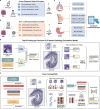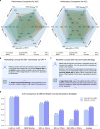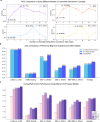Aligning knowledge concepts to whole slide images for precise histopathology image analysis
- PMID: 39738468
- PMCID: PMC11685412
- DOI: 10.1038/s41746-024-01411-2
Aligning knowledge concepts to whole slide images for precise histopathology image analysis
Abstract
Due to the large size and lack of fine-grained annotation, Whole Slide Images (WSIs) analysis is commonly approached as a Multiple Instance Learning (MIL) problem. However, previous studies only learn from training data, posing a stark contrast to how human clinicians teach each other and reason about histopathologic entities and factors. Here, we present a novel knowledge concept-based MIL framework, named ConcepPath, to fill this gap. Specifically, ConcepPath utilizes GPT-4 to induce reliable disease-specific human expert concepts from medical literature and incorporate them with a group of purely learnable concepts to extract complementary knowledge from training data. In ConcepPath, WSIs are aligned to these linguistic knowledge concepts by utilizing the pathology vision-language model as the basic building component. In the application of lung cancer subtyping, breast cancer HER2 scoring, and gastric cancer immunotherapy-sensitive subtyping tasks, ConcepPath significantly outperformed previous SOTA methods, which lacked the guidance of human expert knowledge.
© 2024. The Author(s).
Conflict of interest statement
Competing interests: The authors declare no competing interests.
Figures




Similar articles
-
E2-MIL: An explainable and evidential multiple instance learning framework for whole slide image classification.Med Image Anal. 2024 Oct;97:103294. doi: 10.1016/j.media.2024.103294. Epub 2024 Aug 6. Med Image Anal. 2024. PMID: 39128377
-
Self-interactive learning: Fusion and evolution of multi-scale histomorphology features for molecular traits prediction in computational pathology.Med Image Anal. 2025 Apr;101:103437. doi: 10.1016/j.media.2024.103437. Epub 2025 Jan 3. Med Image Anal. 2025. PMID: 39798526
-
Slide-based Graph Collaborative Training for Histopathology Whole Slide Image Analysis.IEEE Trans Med Imaging. 2025 May 19;PP. doi: 10.1109/TMI.2025.3571152. Online ahead of print. IEEE Trans Med Imaging. 2025. PMID: 40388269
-
Transfer learning drives automatic HER2 scoring on HE-stained WSIs for breast cancer: a multi-cohort study.Breast Cancer Res. 2025 Apr 23;27(1):62. doi: 10.1186/s13058-025-02008-7. Breast Cancer Res. 2025. PMID: 40269991 Free PMC article.
-
Contrastive Multiple Instance Learning: An Unsupervised Framework for Learning Slide-Level Representations of Whole Slide Histopathology Images without Labels.Cancers (Basel). 2022 Nov 24;14(23):5778. doi: 10.3390/cancers14235778. Cancers (Basel). 2022. PMID: 36497258 Free PMC article.
References
-
- Wang, X. et al. Weakly supervised deep learning for whole slide lung cancer image analysis. IEEE Trans. Cybern.50, 3950–3962 (2019). - PubMed
-
- He, K., Zhang, X., Ren, S. & Sun, J. Deep residual learning for image recognition. In 2016 IEEE Conference on Computer Vision and Pattern Recognition (CVPR) 770–778 (IEEE, 2016).
-
- Riasatian, A. et al. Fine-tuning and training of DenseNet for histopathology image representation using TCGA diagnostic slides. Med. Image Anal.70, 102032 (2021). - PubMed
LinkOut - more resources
Full Text Sources
Research Materials
Miscellaneous

